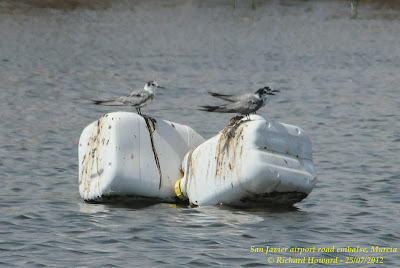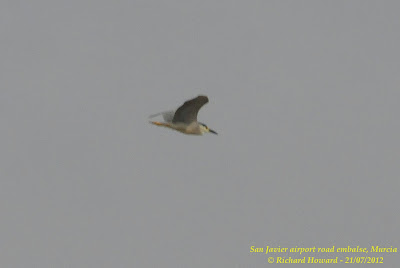Weather: Sky mainly clear, wind F3
NE, temp. 28 - 31ºC. 12:55 - 16:45.
Another
trip around the Mar Menor, again starting with the Salinas at San Pedro del Pinatar and working
back (I know this sounds a bit repetative, but with the only movement locally being of waders and terns, it's the only place to look!).
A midday
start at the Salinas,
where thing were a little more animated than last Saturday. My main reason for returning so much here
(apart from the fact that there is very little to be seen in other places), is
that I’m looking out in particular for Red-necked Phalaropes which tend to be
seen here at this time of year. There
have already been reports over the last few days of birds in the Delta del Ebro
(Tarragona,
Cataluña) in the N.E. of Spain, and Doñana in the S.W., so I know they are in
movement, even if I didn't have any luck today.
There were
definitely a few more waders about, with my first sightings of returning Turnstones, a
single Sanderling and Little Stint and an adult Ruff moulting out of its
breeding plumage. Also, 3 Spotted
Redshank, 6 Redshank and 3 Greenshank, Common Sandpiper and various small
groups of Curlew Sandpipers (I estimated a total of 15). Also different was a single Whiskered Tern
that flew over. The young Little Terns
now seem all able to fly and are collecting at the base of the mud walls where
the nest were although the adults are still feeding them. There seems to be quite a passage of
Black-headed Gulls going through – I counted around 50, mainly adults but with
a few juveniles with them. Also three
adult Mediterranean Gulls, and a single Gull-billed Tern flew over, presumably
returning to the breeding colony in the centre of the Salinas.
One of a few Curlew Sandpipers seen around the salinas
A Common Sandpiper amongst theBlack Winged Stilts
Another recent arrival, a Ruff
A local bred bird, a juvenile Kentish Plover
The flamingos now seem to be well spread out over the salinas, with very little opportunity for ring-reading (they're too deep in the water), although I did manage to read another Algerian ring.
Most of the Greater Flamingos were in water too deep to be able to read rings
Apart from those 'walking on water'
As I was
not time restricted (only heat restricted!), I decided to take a walk partway
down the ‘Mota’ – the pathway at the south end of the Salinas
that divides the Salinas
from the Mar Menor. This is where
traditionally in the summer a large group of Black-necked Grebes accumulates to
moult (I have seen more than 350 birds here on occasion). This time I counted only 32, but this number
will build up as the summer progresses.
Apart from these, things were very quiet birdwise, with a couple of
Black Winged Stilts, 15 Sandwich Terns, 20+ Little Terns and a couple of Curlew
Sandpipers.
Leaving
here at around 15:30, my next stop was again the farm reservoirs close to the
airport in San Javier. Here the only
novelty was a group of 7 Little Ringed Plovers, and the number of Gull-billed
Terns had reduced to around a dozen, but Black Terns were definitely more
numerous with around 15. Also there on
the fences were 9 Cattle and a couple of Little Egrets, 2 adult Night Herons and a
couple of Grey Herons.
Black Terns having a rest in one of the farm reservoirs
Looks like an awkward place to perch for this Night Heron
Night Herons and Egrets lining up on the fence
And away they all go - note the difference in flight between the Cattle (short legs, stubby bills) and Little Egrets
One of the Night Herons decided to have a close look at me!
Another bird that likes to harrass photographers - Black Winged Stilt
My last
stop of the day was the old sewage farm (EDAR) of El Algar. Although this is basically dry (and has been
for some months now), there is a single small pool to the right of the gate
that occasionally has some liquid pumped into it, and a pair of Black Winged
Stilts have bred here. I saw the adult
pair and the single juvenile, and also a single Little Ringed Plover. On nearby overhead power cables, a large
concentration of around 60 Wodpigeons, plus another 60 mixed group of Turtle
and Collared Doves (mainly Turtles).
This seems to be a favorite gathering area for the dove family, possibly
due to the number of Lemon orchards around, as I see these groupings every
year. However, I have noticed that a
large number of the Lemon trees have been grubbed out over the last couple of
months, so maybe I won’t be seeing so many in the years that come.
Species seen/heard
Little
Grebe (Tachybaptus ruficollis)
Black
Necked Grebe (Podiceps nigricollis)
Little
Egret (Egretta garzetta)
Cattle
Egret (Bubulcus ibis)
Night
Heron (Nyctiocorax nyctiocorax)
Moorhen
(Gallinula chloropus)
Coot
(Fulica atra)
Greater
Flamingo (Phoenicopterus roseus)
Shelduck
(Tadorna tadorna)
Avocet
(Recurvirostra avosetta)
Black
Winged Stilt (Himantopus himantopus)
Redshank
(Tringa totanus)
Spotted Redshank (Tringa erythropus)
Greenshank
(Tringa nebularia)
Ruff (Philomachus pugnax)
Sanderling (Calidris alba)
Little Stint (Calidris minuta)
Curlew Sandpiper (Calidris ferruginea)
Little
Ringed Plover (Charadrius dubius)
Kentish
Plover (Charadrius alexandrinus)
Yellow-legged
Gull (Larus michahellis)
Audouin’s
Gull (Larus audouinii)
Black-headed
Gull (Larus ridibundus)
Mediterranean
Gull (Larus melanocephalus)
Slender-billed
Gull (Larus genei)
Gull-billed Tern (Sterna
nilotica)
Sandwich
Tern (Sterna sandvicensis)
Common Tern (Sterna hirundo)
Little Tern (Sterna albifrons)
Black Tern (Chlidonias niger)
Whiskered Tern (Chlidonias hybrida)
Woodpigeon
(Columba palumbus)
Turtle Dove (Streptopelia turtur)
Collared
Dove (Streptopelia decaocto)
Swift (Apus apus)
Iberian Wagtail (Motacilla flava iberiae)
Swallow (Hirundo rustica)
Red-rumped Swallow (Hirundo daurica)
House Martin (Delichon urbicum)
Sand Martin (Riparia riparia)
Fan-tailed
Warbler (Cisticola juncidis)
Greenfinch
(Carduelis chloris)























































